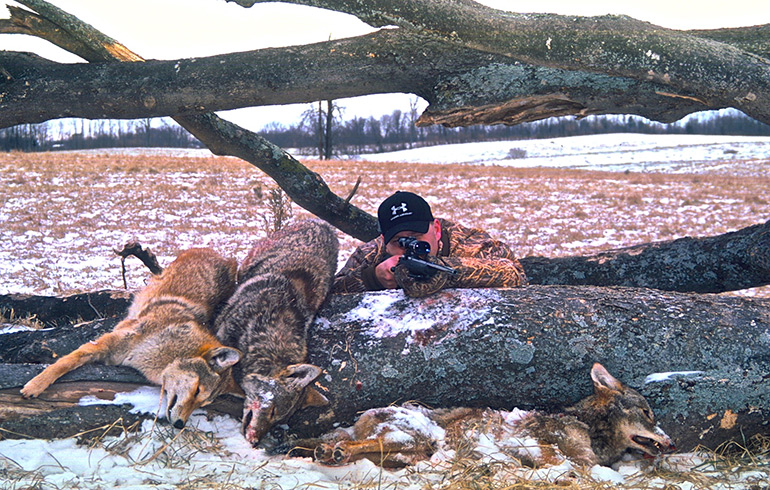Coyotes – Get After ‘Em!
One of the fastest growing hunting sports in the US is coyote hunting. The main reason for this is that coyotes have expanded their range and numbers to the largest levels in modern times, so they are more available to hunt for more people.
One of the best things about coyote hunting is that access is generally pretty easy to obtain. It is increasingly harder and harder to get permission to hunt deer and turkeys, but unless hunting rights are leased, most landowners will allow hunters to access their property to hunt coyotes. When asking permission be courteous and respectful, and I find it helpful to dress in a decent way and not show up on a landowner’s doorstep in camo and muddy boots.

Coyote hunting also requires minimal gear. Good camo clothing, a call or two, maybe a decoy, and a good flat shooting rifle, scope, ammo combination are all that’s required.
You must remember to play the wind at all times when calling coyotes, so make your setups with the wind in your face or at least quartering toward you. I like to try to find sets that allow me to see a long way, and if a barrier to prevent coyotes from coming in from my blind side is available, all the better.
My calling regime is pretty simple most of the time. I prefer a cottontail or jackrabbit distress call, and I hit it pretty hard for 30 seconds to a minute and I pause about 2-3 minutes. More than half of the coyotes that I have called in have shown up within the first five minutes. After the pause, I hit the call again for a minute or so, and then I sit for another 5-10 minutes. If nothing shows, I move on to another location.
Obviously, I am an aggressive coyote hunter, and I don’t employ lots of patience. I would rather hit 10 spots in a morning and spend 10-15 minutes at each than hunting 3 stands for an hour each.
Since electronic calls have taken over the market (check your local hunting regulations), my success has gone way up. I like a call with a remote control, and I usually place them 50 yards in front of me in the open, and I like a furry decoy on a stick in the same location. This setup takes the coyotes attention away from where you are hiding, and once you fool his ears and he sees the prey decoy, he usually commits and comes in much easier than if he hadn’t had a visual stimuli at the call sight.
Getting a coyote to show himself may be the hardest part of the hunt, but you have to be able to shoot him when he does. Coyotes coming in may offer some long range or challenging shots, so being ready and accurate are crucial.
The .223, .243 and my personal favorite the .22-250 are all wonderful coyote rounds. Couple one of these rifles with Winchester’s Varmint X ammunition and you have s serious coyote killer on your hands.
With bullet weights in the 40-58 grain range, the Varmint X line is like hitting a coyote with a little grenade. These loads are inherently accurate, and because of their polymer tip, allow jacket and lead core, they fragment rapidly on even the smallest game. Even if your shot isn’t perfect, the Varmint X will put a serious hurting on a coyote if you hit him virtually anywhere.
One last thing worth mentioning is that in most states, coyote hunting is a year round sport, so when you can’t hunt other game, you can still get outside and pursue your passion. Late winter (late January and February) in bitter cold temperatures is my favorite time to call coyotes simply because they are hungrier and more susceptible to the call, but with a little practice you can consistently kill ‘yotes during any month. One thing I guarantee is that hunting these wily predators is always fun, so go grab your camo, rifle and ammo and get after ‘em!




